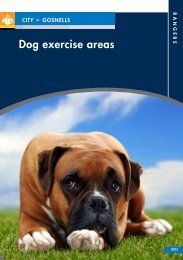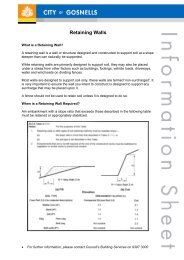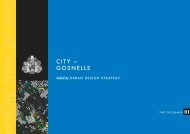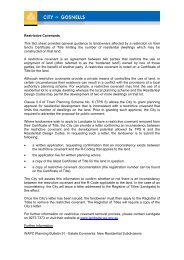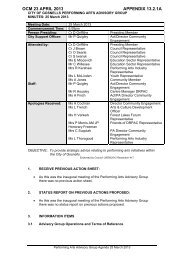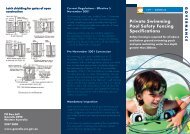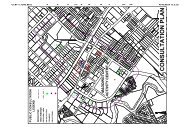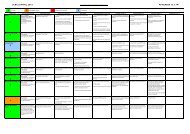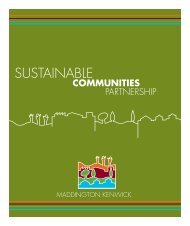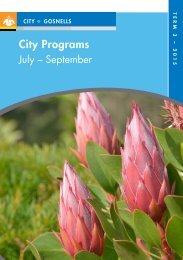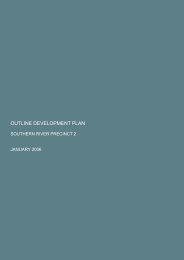Summary - City of Gosnells
Summary - City of Gosnells
Summary - City of Gosnells
Create successful ePaper yourself
Turn your PDF publications into a flip-book with our unique Google optimized e-Paper software.
Vegetation 57Vegetation Unit T4: Melaleuca rhaphiophylla – Eucalyptus rudis - Actinostrobus pyramidalis low openforest to low open woodland.Associates <strong>of</strong> this vegetation also included: Acacia lasiocarpa var. lasiocarpa sens. strict., UAcacia salignaUvar. saligna, Acanthocarpus canaliculatus, Alternanthera nodiflora, Amphibromus nervosus, Anarthrialaevis, Astartea scoparia, Banksia telmatiaea, Baumea juncea, U Bolboschoenus caldwellii, CassytharacemosaU, Casuarina obesa, Chaetanthus aristatus, Corymbia calophylla, Cyathochaeta avenacea,Dichopogon capillipes, Drosera glanduligera, Gahnia trifida, Grevillea thelemanniana, Hakea varia,Hypocalymma angustifolium Mud Habitat Variant (C.Tauss 1850), Jacksonia sternbergiana, Juncuspauciflorus, Lepidosperma longitudinale, Lepyrodia glauca, *ULolium multiflorumU, Lomandra micranthasubsp. micrantha, Meeboldina roycei, Melaleuca osullivanii, Melaleuca viminea subsp. viminea,*Pennisetum macrourum, Schoenus asperocarpus, Schoenus efoliatus, Schoenus pennisetis, Tetrariaoctandra, Thysanotus dichotomus, Tricoryne elatior, Triglochin linearis, Trymalium odoratissimum subsp.odoratissimum and Viminaria juncea.This vegetation was part <strong>of</strong> a complex mosaic fringing channel wetlands in Precinct 3B. The floristiccomposition and structure <strong>of</strong> Vegetation Unit T4 varied according to the level and type <strong>of</strong> disturbance, andhydroperiod (the depth and persistence <strong>of</strong> standing water or waterlogging experienced by the site). Thecanopy <strong>of</strong> this vegetation was dominated by one or more <strong>of</strong> the following: Melaleuca rhaphiophylla,Eucalyptus rudis, Actinostrobus pyramidalis, Acacia saligna or Melaleuca viminea subsp. viminea.Melaleuca rhaphiophylla was most abundant in floodplain areas that were inundated in winter. Actinostrobuspyramidalis occurred on seasonally-waterlogged soils and was largely absent from frequently burnt areas.The riparian vegetation included flora species (Trymalium odoratissimum subsp. odoratissimum andThysanotus dichotomus) that are rare on the SCP but are abundant in the Darling Range; water serves as ameans for the dispersal <strong>of</strong> plant propagules <strong>of</strong> such species from the Darling Range towards the CanningRiver.Much <strong>of</strong> this area has experienced a number <strong>of</strong> disturbances (including the clearing <strong>of</strong> native vegetation, thedeepening <strong>of</strong> the channel <strong>of</strong> the watercourse, the dumping <strong>of</strong> fill, frequent burning in some areas, grazing andweed invasion). The more disturbed native vegetation fringing Yule Brook had an open canopy over adegraded understorey dominated by dense stands <strong>of</strong> the naturalized alien grass *Pennisetum macrourum or*Watsonia meriana var. bulbillifera. Other invasive weeds in degraded parts <strong>of</strong> this vegetation includedpatches <strong>of</strong> *Acacia podalyriifolia, *Allium triquetrum, *Chamaecytisus palmensis and *Zantedeschiaaethiopica. All <strong>of</strong> these weeds are probably spread by machinery involved in the excavation <strong>of</strong> watercoursesto reduce local flooding.The dense scrub, woody litter and the dense grass weeds along watercourses provide good native faunahabitat and form an important fauna corridor from the Darling Range to the Canning River. There wereabundant birds noted in the area at the time <strong>of</strong> the survey and Isoodon obesulus (Quenda) diggings werefrequent. The native water rat Chrysomys melanogaster (Rakali) may also still use this corridor.Whilst the course <strong>of</strong> the Yule Brook may have been somewhat straightened and the channel excavated overpart <strong>of</strong> the MKSEA, it is important to note that the long term position <strong>of</strong> this waterway is clearly indicated byspecific native vegetation (as mapped in this survey) and the surface sediments mapped in Jordan (1986; seeunit MS4 in Figure 6). This pattern <strong>of</strong> deposition <strong>of</strong> floodplain sediments along the natural, long term course<strong>of</strong> Yule Brook indicate that this watercourse has conformed fairly closely for many years to the vicinity <strong>of</strong>the current channel. However, an investigation <strong>of</strong> the deeper sediments <strong>of</strong> the area (VCSRG, 2001) hasprovided evidence <strong>of</strong> the more extensive meandering <strong>of</strong> watercourses draining from the Darling Range inthis area (such as the current Yule Brook and Bickley Brook) over much longer, geological time frames.Vegetation Unit T5: Melaleuca rhaphiophylla – M preissiana. - low open forest over Xanthorrhoea preissiigrass trees and Lepidosperma longitudinale-Cyathochaeta teretifolia closed sedges.Common associates <strong>of</strong> this unit included: *Acacia longifolia, Acacia saligna var. saligna,*Amphipogonsetaceus, Aphelia cyperoides,*Anagallis arvensis var. caerulea, Aotus gracillima, Astartea affinis,Centrolepis aristata, *Cicendia filifolia,*Cortaderia selloana, ,*Eragrostis curvula, Dampiera linearis,Dielsia stenostachya, Gastrolobium ebracteolatum, Hypocalymma angustifolium Sand Habitat Variant(C.Tauss 1895), Lepyrodia glauca, ULobelia anceps, *Lotus subbiflorus, Meeboldina roycei, Patersoniaoccidentalis var. angustifolia ,*Ricinus communis, *Schinus terebinthifolius, Senecio pinnatifolius var.Tauss, C. and Weston, A.S. (2010). The flora, vegetation and wetlands <strong>of</strong> the Maddington-Kenwick Strategic Employment Area.A survey <strong>of</strong> the rural lands in the vicinity <strong>of</strong> the Greater Brixton Street Wetlands. Report to the <strong>City</strong> <strong>of</strong> <strong>Gosnells</strong>, W.A. Version 18.04.10




